Packrafting – An activity in which you add even more weight to your pack (PFD, packraft, paddles, kit) and schlep it all down to the river so you can float down the river in something the step up from a pool toy, get wet while paddling, get muddy because you tend to hike out via lesser-known canyons vs. a defined area, and then haul it all again UP another canyon. But you do get great views! 😉 – From an earlier trip report.

I continue to get more general inquiries about our packrafting gear. I wrote a quick overview previously, but I buried it somewhat in a trip posting.
Because of the continued inquiries, a somewhat more thorough explanation of what Joan and I use and why we use it might make for an interesting article.
With no further ado, here’s the packraft gear we use, our thoughts behind it’s, and what we may reconsider for future use.
How we use our gear
As I detailed before, the use case for the more popular packrafting is day paddle trips with not as much, if any, hiking.
People buy heavier packrafts, if very compact, vs. other watercraft, for day use and shuttles—rafting trips with less emphasis on the packing portion of packrafting.
Joan and I primarily come from a backpacking background, and packrafting allows us to connect the canyons to hike more along the Colorado Plateau. As we only have one 4WD-capable vehicle, we prefer loop trips. Most packrafting trips on the Colorado Plateau tend to be on or near rougher areas, esp if you take more backcountry-focused trips and do not use established boat launches. We tend to hike by ourselves and prefer not to arrange group trips and shuttles.

Our “trailhead” marked by this very old cairn on some jeep track.
As it is the Colorado Plateau, carrying four liters of water at a time is not uncommon.
Meaning, weight, and packability for comparatively small and self-contained packs are of utmost importance to us.
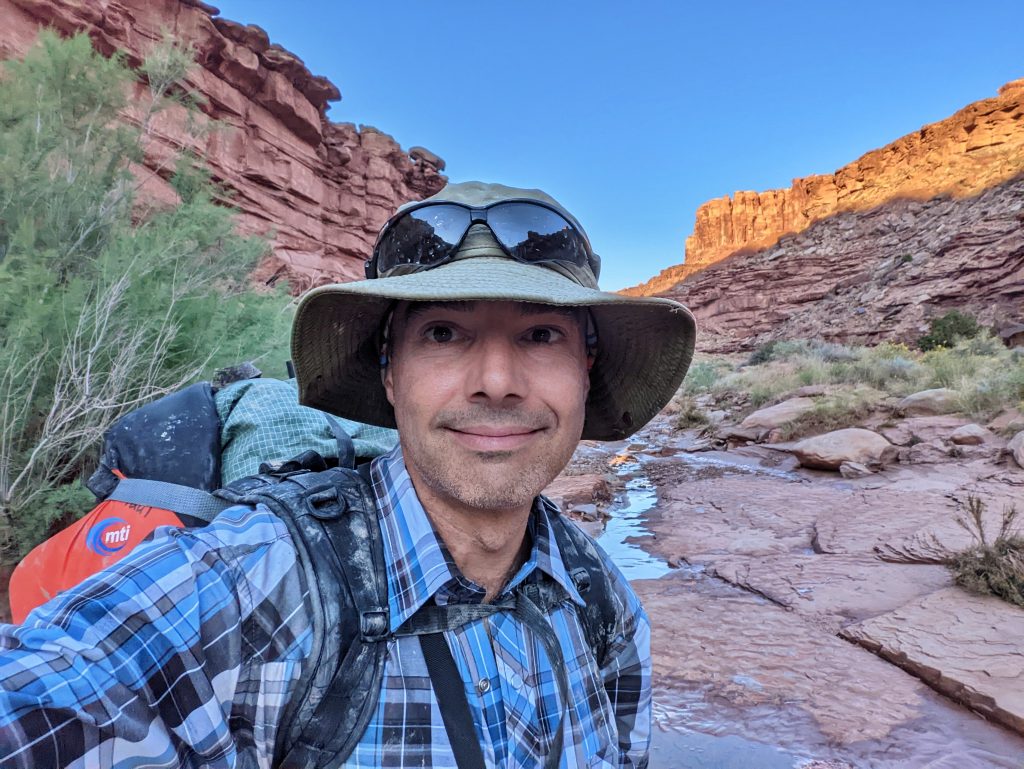
Hauling gear on a hike up the exit canyon.
As other baselines, our trips tend towards a 65/35 to 50/50 split of hiking to paddling ratio with three-season conditions and up to class II whitewater (as I found out after the fact. Ha! 🙂 ). In other words, April to October or early November on the Colorado Plateau.
A 9lb+ packraft seems small compared to a trailered boat, but that’s nearly five days of food for most backpackers. And not something that would work for our needs.
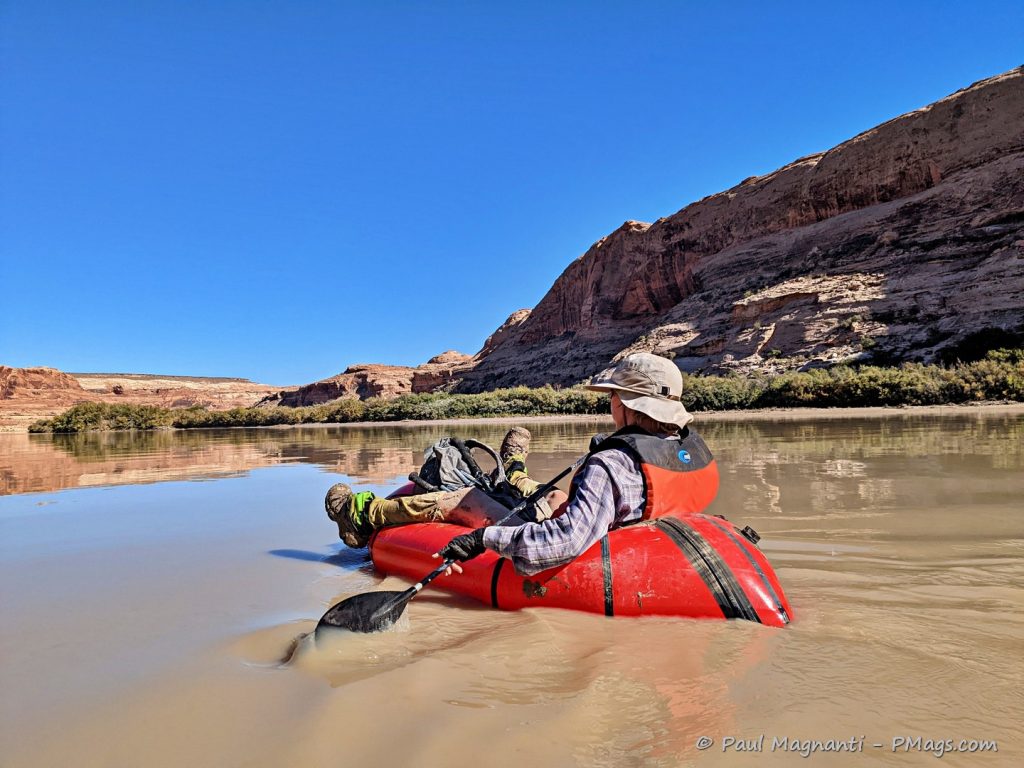
Our Boats
Though Klymit makes some budget packrafts for crossing and calm floats, the use case seems limited vs. what Joan and I want for packrafting trips. And many people, myself included, made do with the Intex 200 for dirtbag packrafting; it’s also heavy, bulky, and limited use.
That means we had a few limited options when we purchased our boats in 2019, and all those options pointed toward Alpacka.
Based in Montrose, CO, this manufacturer of packrafts is still the “go-to” for the increasingly popular niche activity.
Two options worked for us when we purchased boats: The Classic and the Scout.
To put it into backpacking metaphors, the Classic raft is the ULA Catalyst – A “do-it-all” heavy hauler that handles many conditions and takes a beating. It’s also heavier, expensive, and not as compact. Weighing in at 7+ lbs, the Alpacka Classic makes too much of a raft for our needs and is much too heavy. If I am built like Gimli and can haul weight (along with being hairy and speaking with a bit of a funny accent), Joan is tall and of a more-slender frame. Hauling the equivalent of 3+ days of food in addition to our normal Utah backpacking load would not work. It also costs about $1300 in 2022.
Using the pack analogy, the Scout is more like the ULA CDT. – Durable, surprisingly capable, but with limitations. At 48 oz, the Scout can handle up to Class 1 or 2 rapids, haul enough weight for most backpacking purposes, and handle better than expected, according to people with more paddling experience than myself. At $650, it made an affordable option (relatively) for our needs.
The downside is that even Class II rapids push the limit of the Scout; the open configuration means water gets in, and you are less protected from the cold water. A problem in April or late October/early November, even on the Colorado Plateau. Wearing rain gear and pull-offs to bail water mitigated the problems for Joan and me somewhat.
All gear is a compromise, and packrafts make no exception.
Overall, the Scout works for our needs.

Looking ahead as my skillset and range of packrafting increases, the new (2022) Alpacka Refuge seems as close to a “quiver of one” packraft as you can get for those into backcountry adventures. The initial reviews seem reasonable and looks like the packraft equivalent of my beloved ULA Circuit.
At 5.5 lbs, it spanned the two backpacking-focused packrafting options available in 2019. It is nearly $1300 and not something I plan to purchase soon
A company making custom packraft options for fewer dollars received initial positive reviews. But the lack of longer-term use makes me hesitant for now. But something to consider in the future.
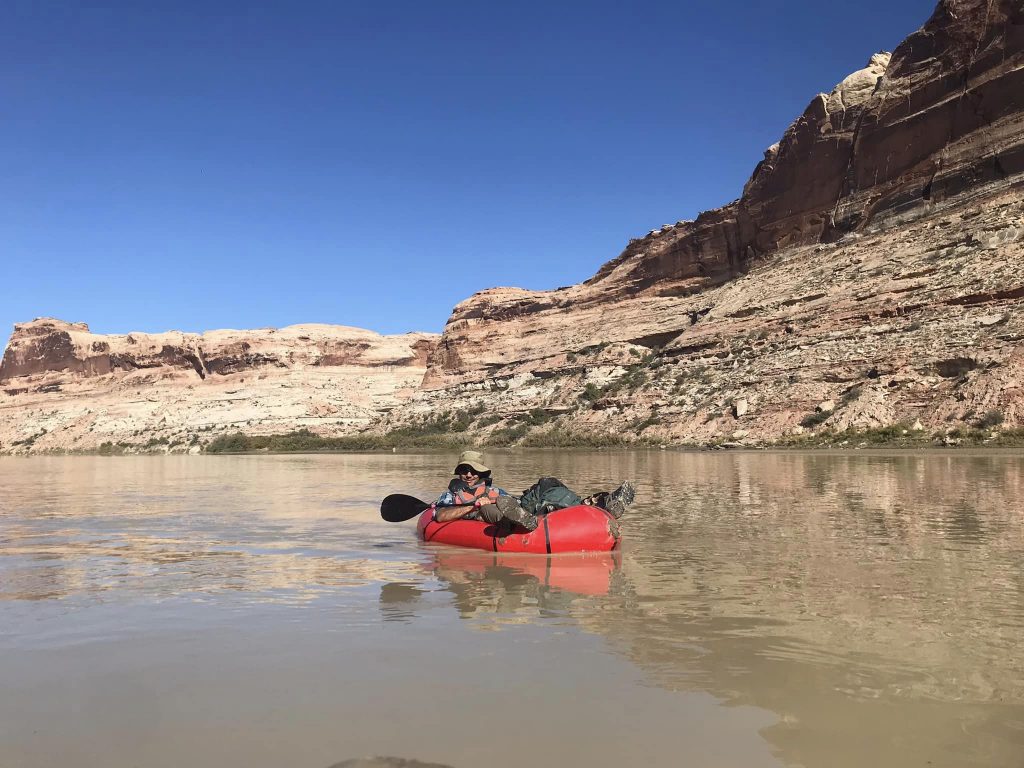
PCO Joan.
Paddles
We also wanted light paddles as we hike more and paddle less in typically moderate conditions. The 15 oz and $175 Ninja Paddles work for our needs (no longer made, it seems). They need some TLC and do not float, however.
After every trip, I perform maintenance on them, similar to my hiking poles. Some firearm oil, pipe cleaners, and a sun blast ensure these poles stay dry and do not oxidize.
For more paddle-focused trips and difficult conditions, something more durable, but nearly twice the weight, might need to get schlepped.
In the meantime, we have some inexpensive Intex paddles for day trips when we want to have fun or practice. They weigh right at 32 oz and break into sections. Truthfully, they may work well enough to save money (and maintenance) if we get different boats for only a 3 oz penalty vs. the more expensive paddles above.
UPDATE 2023 – And that’s just what I did for a trip that started off with 70 miles of paddling during a high flow year with ~10 miles to hike out. The Intex paddles broke down easily for packing, stood up well in terms of durability, and required little maintenance
Overall, more oversized paddles make paddling much easier and more efficient. But more weight and bulk. Again, all gear makes for a trade-off.
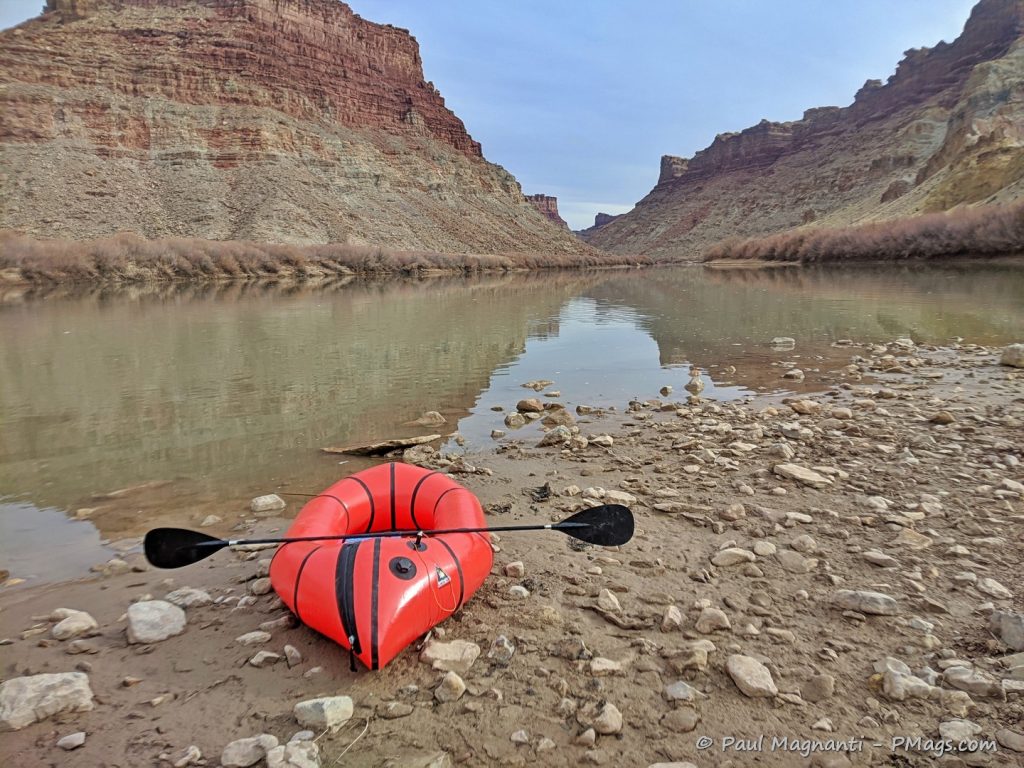
PFDs
Perhaps I know too many people in search and rescue, and we typically go by ourselves and not near people, but we always wear a PFD. Too many people have accidents in benign conditions, and I don’t think we gain anything by not taking a PFD. Joan feels likewise.
We use the MTI Daytrippper PFDs. At 14 oz, the lightest Type III PFD, it seems. At $40 an affordable and safe option. A bit more challenging to get, however (Supply chain issues?) Otherwise, the Astral PFD at just over 1 lb, but $135, seems another option.
Other accessories
A simple and light fanny pack, or, in Joan’s case, a rigged-up SMD pack pod, helps keep the phone (navigation and photos), snacks, map, and 3m of accessory cord handy. The accessory cord gets used for landings and securing our raft—a valuable set of items fo 1.5 oz of weight.
Additionally, we’ve found that a dry bag for a 4.5oz weight penalty repeatedly proved a worthy piece of gear to protect our quilt beyond a compactor bag.
For colder trips, Joan will pack the Alpacka Scout Seat that weighs 5 oz for comfort. Otherwise, she’ll use a foam pad as I do.
Lastly, I carry an inflation bag that weighs 5 oz. One works well enough for both our boats.

For those keeping track, all together, we each carry 5 to 5.5 lbs of additional gear when we go packrafting.
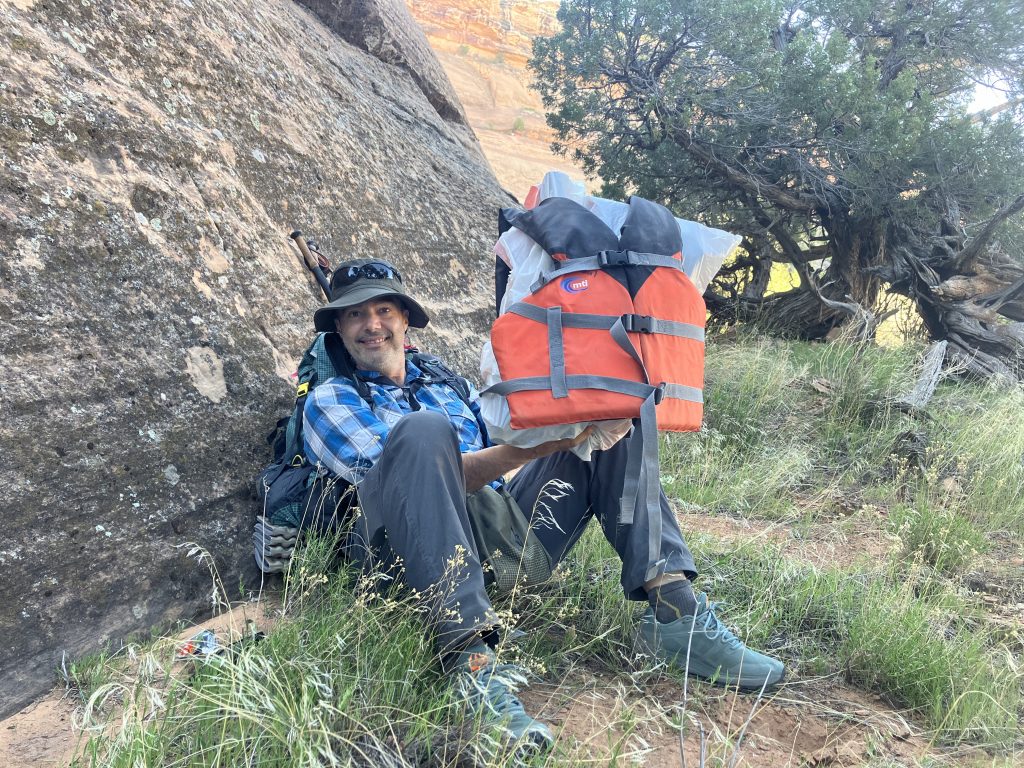
The total gear I carry (including paddles). We stashed it as we walked up the canyon and retrieved it the following day. PCO Joan.
All our pack rafting gear, minus the Intex paddles, neatly fit in one Flyers Kit Bag in our gear room closet. I’ve talked about this $35 wonder many times, and I think it’s one of the better gear purchases I’ve made over the years.
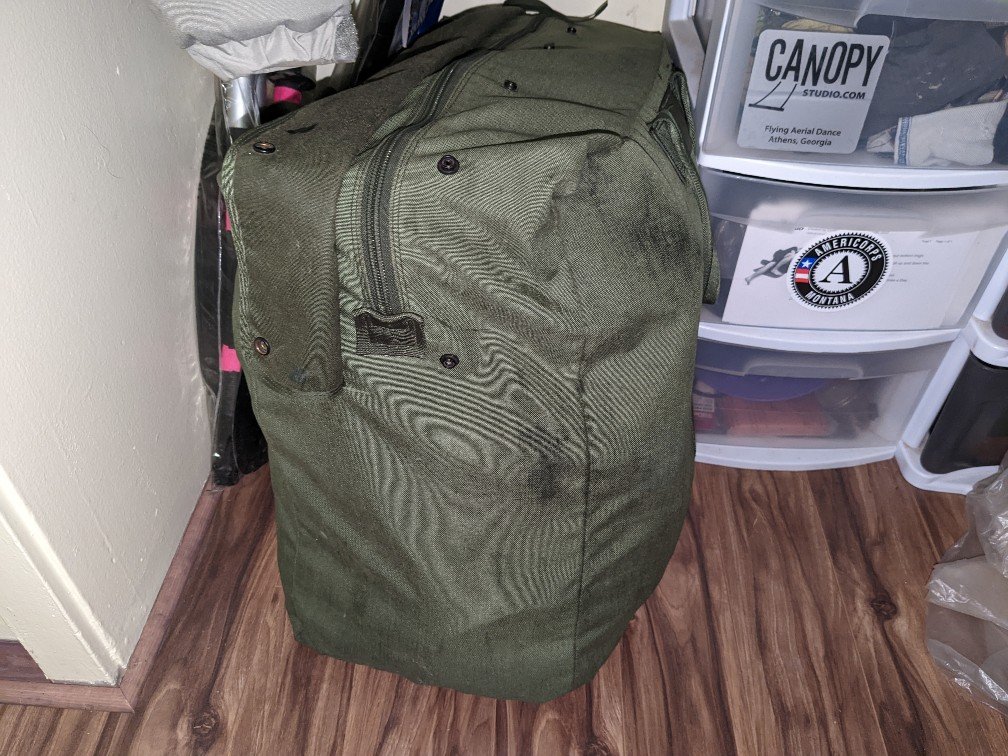
I mark the paddles I use with pink duct tape.
Packs
Because we tend to PACKraft, we want to ensure the packs work well for us.
When solo, I take the ULA Circuit. It’s large enough to haul gear, food, water, packrafting gear, and even colder weather clothing. I could use a ULA CDT, but that means I start playing Tetris with my pack. And unless it’s something like a thru-hike with a one-off paddle, I don’t see the need or utility to carry a small pack.
When I go with Joan and take our preferred tent and perhaps some extra gear, I’ll step up to the ULA Catalyst. The ULA Catalyst makes for my “heavy hauler” workhorse for guiding and overnight ski tours.
I also find that ULA packs stand up to the rigors of Utah backpacking.
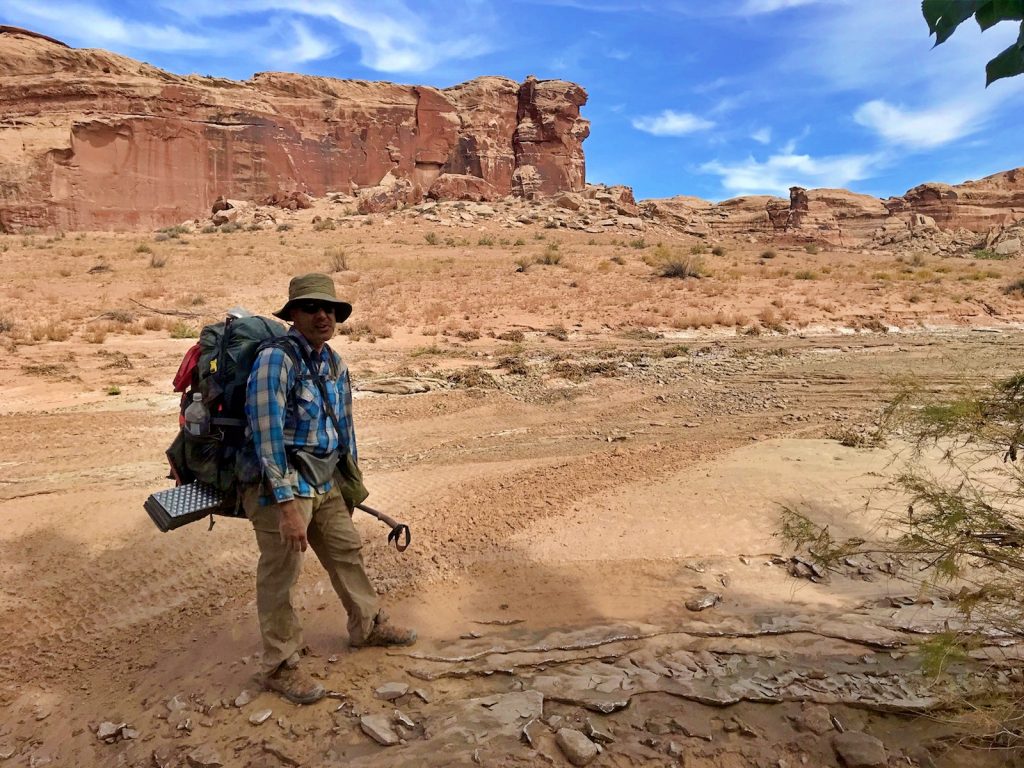
And if your hiking pants are still wet and caked with mud from the day before, the fanny pack is handy!
Joan prefers her 2016 Gossamer Gear Mariposa when packrafting. The current model may differ somewhat from hers, but Joan likes how the Mariposa carries for her, its capacity, the separate foam sit pad area, and the internal gear organization. As I mentioned above, Joan’s 5’10” frame tends towards the slender size vs. my 5’6″ Gimli-like build.

Different packs fit different people, well, differently. But the above may give some helpful info.
____
And that’s the gear we use for the backpacking-focused trips that work well for us. In the future, I can potentially see an additional raft in our quiver. But overall, I think we’ll still have the gear dialed in for a while.



Do you put your circuit inside your packraft and if so, how easy is it to put inside the tizip cargo zipper
Hi Vanessa, Any pack with a frame will, more than likely, NOT fit in the tzip. When I paddled on the Colorado for ~70 miles, I used the tzip, but my pack itself stayed outside of the tubes. https://pmags.com/on-the-south-east-utah-group-seug-circuit I use the Catalyst for trips with my partner and the Circuit when solo. A frameless pack may fit in the tzip, but it does not have enough support for most people with heavier packraft gear, days of food, and the amount of water needed for desert hiking, I suspect. I schlepped a poor person’s packraft (Intex 200) with water and… Read more »